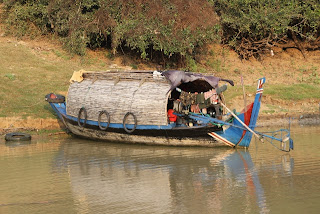This was going to be the perfect border crossing. Having weighted all the options carefully, we had selected a “slow boat”, a large metal boat with the ideal deck terrace, comfortable chairs, sun roof. Bar onboard, with soft drinks, beer – of course – and coffee and tea, a spacious toilet, and in case it gets too hot outside, plenty of room under-deck, on comfortable benches. No need for our pillows here! Six hours, not that much more than the fast boat, which was a much smaller, closed plastic contraption, with limited view from inside seats only. Departure 8.30 am, perfect timing, and all the way through to Chau Doc. As it turned out, we had the whole boat practically for ourselves, with only four other passengers. Perfect it was!
Until we moored somewhere half way, well before the border, and were told to change into… indeed, one of those claustrophobic plastic contraptions. The slow boat wasn’t going any further. Apparently, the slow boat never goes any further, is not allowed into Vietnam. Hard to believe that the tour company representative didn’t know this, so we can only conclude that the travel industry is made up of cheating and lying bastards. But we knew that already, of course – our previous border crossing wasn’t exactly as we were made to believe, either -, just being confronted with this time and again remains frustrating.
(1) The slow boat and the plastic contraption next to each other: now you understand why we were so upset that we had to change.
(2) We were not the only ones comfortable in our original boat.
As it happened, the actual border crossing was extremely efficient, five minutes on the Cambodian side, a little longer, including lunch, at the Vietnamese side, and no uncertain additional charges, this time.
But back to the trip, which was a whole new experience. We boarded our boat at the jetty in Phnom Penh, in the Tonle Sap River, which joins the Mekong a little further downstream. The Mekong is a lot bigger here, and supports much bigger vessels – but still the small fishing canoes, as well. Most transport goes downstream, so whatever goes that direction is low, extremely low, in the water. Rice, mainly, in open boats, which have been heightened with sacks – also filled with rice – to allow a bigger pay load. It is a miracle that this rice doesn’t flush away with the first waves from other passing ships. But for the rest this part of the river isn’t particularly interesting. Yet I all the time have to think of the story told by Jon Swain, in his book Rivers of Time about the 1970s in Indochina. He traveled from Saigon to Phnom Penh early 1975, when Phnom Penh was under siege from the Khmer Rouge and the only life line for the city was food imports from an American air bridge, and daredevil boat captains who sailed up the Mekong. Jon was on one of those boats, and describes the shelling of his boat by Khmer Rouge artillery from the protection of the jungle, just before reaching Phnom Penh. As he tells it, you really feel vulnerable, but I reckon, as long as you stick to the middle, you should be pretty safe, given the width of the river here. But I am not an artillery expert, of course. And I wasn’t there at the time.
(3, 4) Fishing canoes in a sea of water.
(5, 6) Larger boats empty…..
(7, 8) and this is how they look when filled with rice.
As soon as we get into Vietnam, the scenery changes. The river comes alive again, there is a lot happening, much to see. The irritation from changing boats is quickly forgotten. It is busier, and greener: unlike most of Laos and Cambodia, the Vietnamese run rice paddies in the dry season, too, through irrigation, and it shows, from the endless green stretches, occasionally interrupted by a conical hat. Indeed, it seems almost all Vietnamese wear these things, and when crouched low in the fields, the only thing the boat passenger sees is a hat sticking out of the rice fields.
The delta becomes what you expect from a real delta, with an ever increasing number of bigger and smaller river channels networking towards the sea. And with so many people here, all these channels are busy with boats of all sizes, from freighters to fishing canoes. And ferries, big and small. We switch to the Bassac River, another sizeable delta channel, and we get to Chau Doc, the first larger city inside Vietnam, in, what?, something like six hours. It really doesn’t make any difference taking a slow or a fast boat. Except for the comfy deck chairs.
(9) Border villages – this one is just inside Vietnam – don’t have satellite TV yet, obviously.
(10) Conical hat sticking out of a rice paddy – I know, not a brilliant photo, but just to give you an idea.
(11) Ferry boat crossing one of the smaller channels.


















































